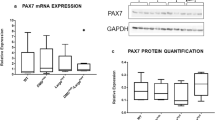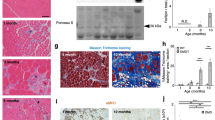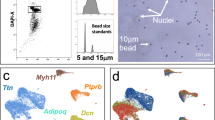Abstract
The extensive proliferation of connective tissue in muscular dystrophy caused Duchenne1 to term it ‘paralysie myosclerosique’. Surprisingly, there has been little interest in the pathogenesis of this marked fibrosis or of the fat replacement in dystrophic muscle. The fibrosis has generally been considered secondary, with various hypotheses2 to explain the fundamental cause of muscular dystrophy. Several authors have commented on the increased endomysial stroma early in the disease before any apparent muscle degeration3,4 and have suggested that there might be an aberration in the production of connective tissue in muscular dystrophy and that the thickening pericellular reticulum would adversely affect muscle nutrition5,6. lonasescu and his collaborators found an over-production of connective tissue with a concomitant decrease in muscle protein synthesis both by polyribosomes from skeletal muscle and by tissue culture of muscle tissue and skin fibroblasts from patients suffering from Duchenne muscular dystrophy7–9. Thomson et al.10 have observed in tissue culture that dissociated muscle from patients with Duchenne and Becker muscular dystrophy will form unusual clusters of ‘sticky’ cells, which they suggested may reflect an abnormal collagen production. These findings have cast doubts on the interpretation that the extensive connective tissue proliferation characteristic of Duchenne muscular dystrophy, and also seen in limb-girdle, Becker and congenital dystrophies, is simply due to a compensatory replacement of the wasting muscle11 but infers a more primary role for the connective tissue collagen. Only recently has the role of connective tissue in developing muscle come to be appreciated12–14. Moreover, immunofluorescent techniques14–16, now allow investigation of the various types of collagen present in skeletal muscle. We report here on the localisation and change in proportion of collagen types I, III, IV and V in muscle from patients with various forms of neuromuscular disease, and propose a more positive role for collagen.
This is a preview of subscription content, access via your institution
Access options
Subscribe to this journal
Receive 51 print issues and online access
$199.00 per year
only $3.90 per issue
Buy this article
- Purchase on Springer Link
- Instant access to full article PDF
Prices may be subject to local taxes which are calculated during checkout
Similar content being viewed by others
References
Duchenne, G. B. Archs gén. Méd. 6, 5 (1868).
Rowland, L. P. Arch. Neurol. 33, 315–321 (1976).
Pearson, C. M. in Muscular Dystrophy in Man and Animals (eds Bourne, G. H. & Golarz, M. N.) (Hafner, New York, 1963).
Bell, C. & Conen, P. J. neurol. Sci. 7, 529–544 (1968).
Bourne, G. H. & Golarz, M. N. Nature 183, 1741–1743 (1959).
Cazzato, G. Eur. Neurol 1, 158–179 (1968).
Ionasescu, V. H., Zellweger, H. & Conway, T. Archs Biochem. Biophys. 144, 51–58 (1971).
Ionasescu, V. H., Zellweger, H., Ionasescu, V. I., Braud, C. L. & Cancilla, P. A. Acta neurol. scand. 54, 241–247 (1976).
Ionasescu, V., Braud, C. L., Zelleweger, H., Ionasescu, R. & Burmeister, L. Acta neurol. scand. 55, 407–417 (1977).
Thomson, E. J., Yasin, R., Van Beers, G., Nurse, K. & AlAni, S. Nature 268, 241–243 (1977).
Dubowitz, V. Muscle Disorders in Childhood (Saunders, London, 1978).
Lipton, B. H. Devl Biol. 61, 153–165 (1977).
Wolpert, L. Scient. Am. 239, 124–137 (1978).
Bailey, A. J., Shellswell, G. B. & Duance, V. C. Nature 278, 67–69 (1979).
Duance, V. C., Restall, D. J., Beard, H., Bourne, F. J. & Bailey, A. J. FEBS Lett. 79, 248–252 (1977).
Duance, V. C., Black, C. M., Dubowitz, V., Hughes, G. & Bailey, A. J. Muscle Nerve (in the press).
Bailey, A. J., Duance, V. C., Sims, T. J. & Beard, H. K. Front. Matrix Biol. 7, 49–59 (1979).
Bailey, A. J., Bazin, S., Sims, T. J., Le Lous, M., Nicoletis, C. & Delaunay, A. Biochim. biophys. Acta 405, 412–421 (1975).
Fitchett, D. H., Scott, J., Stephens, H. R. & Peters, T. J. Cardiovasc. Res. 13, 260–268 (1979).
Jerusalem, F., Engel, A. G. & Gomez, M. R. Brain 97, 115–122 (1974).
Mair, W. G. & Tome, F. M. Atlas of the Ultrastructure of Diseased Human Muscle, 140 (Churchill, London 1972).
Carpenter, S. & Kapati, C. Brain 102, 147–161 (1979).
Neville, H. in Muscle Biopsy: A Modern Approach (eds Dubowitz, V. & Brooke, M. H.) Ch. 12 (Saunders, London, 1973).
Cullen, M. J., Appleyard, S. T. & Bindoff, L. Ann. N.Y. Acad. Sci. 317, 440–465 (1978).
Vracko, R. Biology and Chemistry of Basement Membranes (ed. Kefalides, N. A.) 165–176 (Academic, New York, 1978).
Author information
Authors and Affiliations
Rights and permissions
About this article
Cite this article
Duance, V., Stephens, H., Dunn, M. et al. A role for collagen in the pathogenesis of muscular dystrophy?. Nature 284, 470–472 (1980). https://doi.org/10.1038/284470a0
Received:
Accepted:
Issue Date:
DOI: https://doi.org/10.1038/284470a0
This article is cited by
-
Muscle fibrosis as a prognostic biomarker in facioscapulohumeral muscular dystrophy: a retrospective cohort study
Acta Neuropathologica Communications (2023)
-
Key concepts in muscle regeneration: muscle “cellular ecology” integrates a gestalt of cellular cross-talk, motility, and activity to remodel structure and restore function
European Journal of Applied Physiology (2022)
-
Origins, potency, and heterogeneity of skeletal muscle fibro-adipogenic progenitors—time for new definitions
Skeletal Muscle (2021)
-
A 96-well culture platform enables longitudinal analyses of engineered human skeletal muscle microtissue strength
Scientific Reports (2020)
-
Diagnosis of a model of Duchenne muscular dystrophy in blood serum of mdx mice using Raman hyperspectroscopy
Scientific Reports (2020)
Comments
By submitting a comment you agree to abide by our Terms and Community Guidelines. If you find something abusive or that does not comply with our terms or guidelines please flag it as inappropriate.



